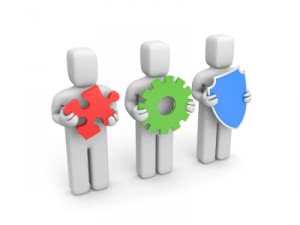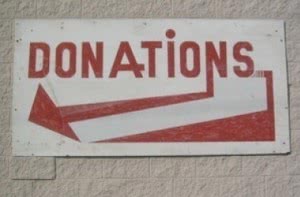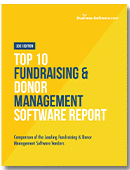CRM
Nonprofit Donor Management
Traditional CRM vs. Donor Management Software: Why the Differences Matter

Welcome to Business-Software.com’s Nonprofit Week special! Connect with us on Twitter or Facebook to continue the conversation and receive updates on other exclusive Business-Software.com series and events.
With limited time and resources, it’s important to find software that can solve your problems, not add to them. Upon first glance, traditional customer relationship management (CRM) software and nonprofit donor management software seem to be synonymous. Certain nonprofit donor management software solutions have even commandeered the CRM abbreviation and replaced the original interpretation to mean constituent or contact relationship management software. Yet any nonprofit knows that traditional CRM solutions just won’t cut it when it comes to organizing, tracking and managing constituents. While traditional CRM solutions might sustain operations for a short time, they aren’t a long-term solution. Donor management software offers nonprofit-specific tools that cater to a NPO’s unique needs.
The Similarities
Both traditional CRM and nonprofit donor management software oversee and facilitate a company’s relationship with customers and constituents respectively. These solutions also provide data and insight into the preferences and habits of customers or constituents, and help organizations use this information to make well-informed operations and marketing decisions.

1. Understanding the Customer or Constituent Base
With tools like lifecycle management, prospect research, segmentation and drill-down reporting, both traditional CRM and nonprofit donor management software transform raw customer/constituent data into insight and information used to improve a company’s rapport with these individuals.
2. Communication Tools
Email marketing, social media and direct mail are all viable methods for connecting with a customer or constituent base. While the breadth of these tools can vary, both segments offer tools that can streamline communication and encourage customer or constituent action. Both offer built-in, customizable templates that make it easy to send messages to specific groups of people.
The Differences
While it’s technically possible for nonprofits to use traditional CRM software to manage constituent relationships, nonprofit donor management software provides an array of nonprofit-specific tools that are vital for organizing, tracking and utilizing these unique relationships.
1. Cost
While cost is based on a variety of factors, traditional CRM products are generally more expensive than nonprofit donor management software (when similar functions are offered). This is due, in part, to the fact that for-profit organizations use CRM software to increase profits, while nonprofits use the tools as much for organization and transparency as boosting funds. When profits are the end-all goal, companies are likely to spend more knowing that the ROI will easily pay back up-front costs. Nonprofits aren’t as likely to splurge on costly software.

2. Tracking Donation Types
Although for-profit companies rely on and measure success by the revenue they make from selling products and services, donations are the lifeblood of nonprofit organizations, and are ultimately responsible for their survival or failure. Donations come in many forms, and donor management fundraising software is equipped to process in-kind donations without monetary value, pledges, time volunteered, soft credits, traditional money donations, honor donations and more. While for-profit companies usually focus on profitability, NPOs usually focus on accountability. Aside from providing robust tools created specifically to handle a variety of donations types, nonprofit donor management software can help create and manage fundraising event registrations, attendance and invitations. Traditional CRM solutions lack these important features.
3. Reporting and Analytics
Traditional CRM software is designed to follow a customer throughout his or her lifecycle and drill down to find hidden data on customer trends that can help marketers make informed decisions. Nonprofit donor management fulfills a similar role, but for constituents instead of customers. Despite these words being used interchangeably by some, customers and constituents are completely separate entities and therefore must be tracked and managed differently.
While customers can be easily segmented based on any number of factors, constituents often fulfill multiple roles at any given time. For instance, an individual could be both a volunteer and a board member or both a member and a donor. Customers are defined primarily by their monetary contribution, whereas constituents must be defined by their specific contribution, monetary, in-kind or otherwise, to the organization. Due to the increased call for nonprofit transparency, tracking and recording these groups of people is an integral task for any nonprofit, and only donor management software offers constituent-based tracking tools.
In A Nutshell
It’s true that traditional CRM and nonprofit donor management software perform similar functions at their most basic level. However, the discrepancies between the software solutions may make the difference between a nonprofit surpassing or falling short of its goals. Nonprofit donor management has specific tools that not-for-profit organizations need to organize constituents and make use of the unique data they measure and track. These tools can improve fundraising campaigns and ultimately increase the business’ success in a way that traditional CRM is ill-equipped to handle. To find the perfect solution for your NPO, check out our free report on the Top 10 Nonprofit Donor Management software solutions.
For  an in-depth profile of some of the top nonprofit donor management software products available, check out our exclusive Top 15 Nonprofit Donor Management Software report.
an in-depth profile of some of the top nonprofit donor management software products available, check out our exclusive Top 15 Nonprofit Donor Management Software report.
Have you recently switched from a traditional CRM to a nonprofit donor management software solution? Tell us about your experience in the comments below.






